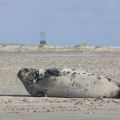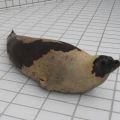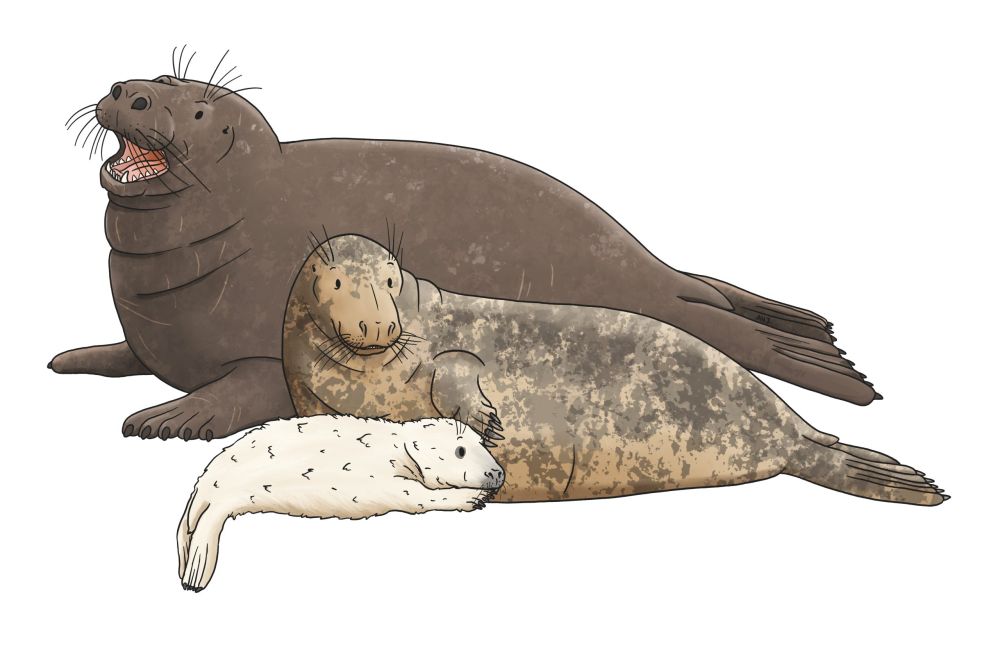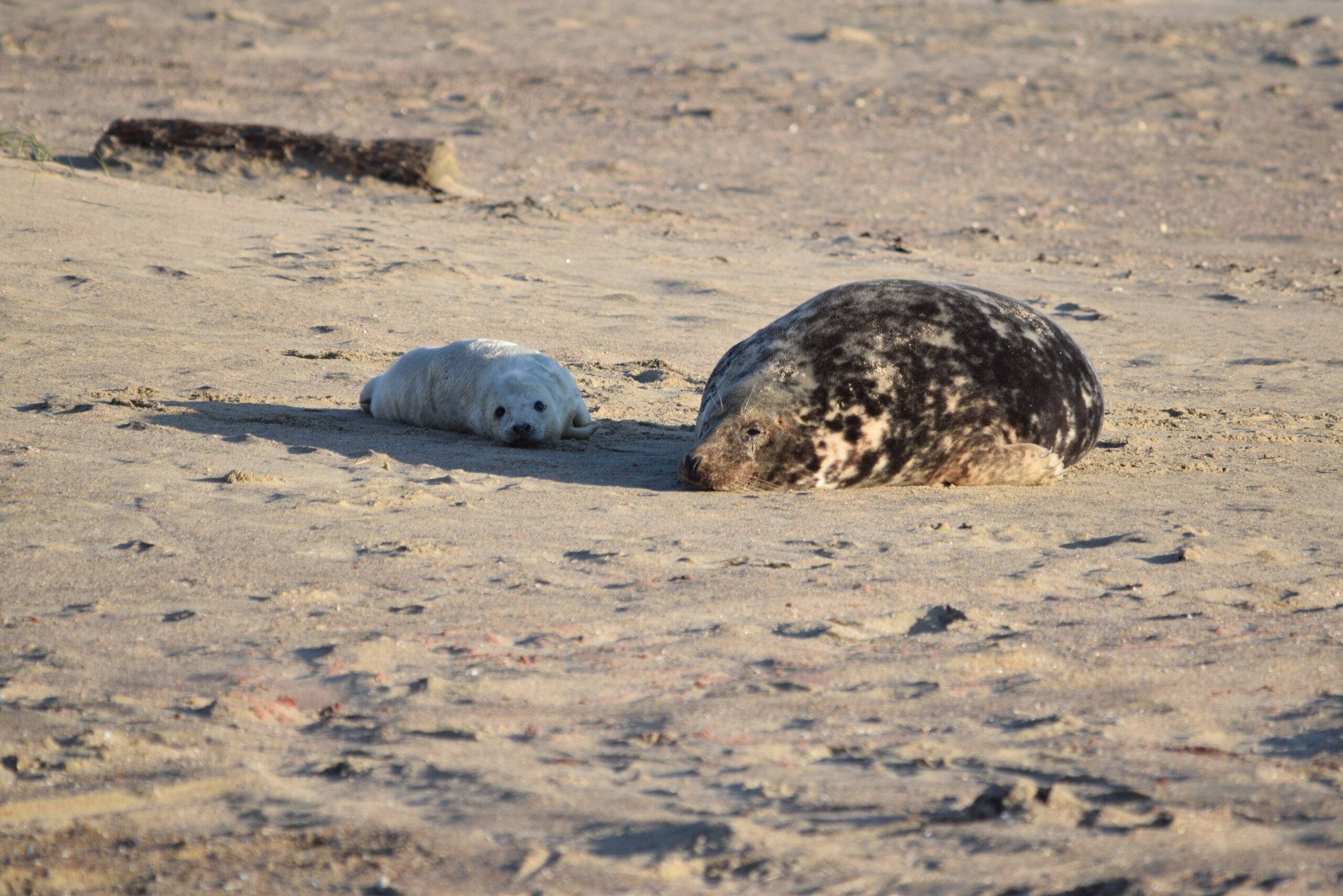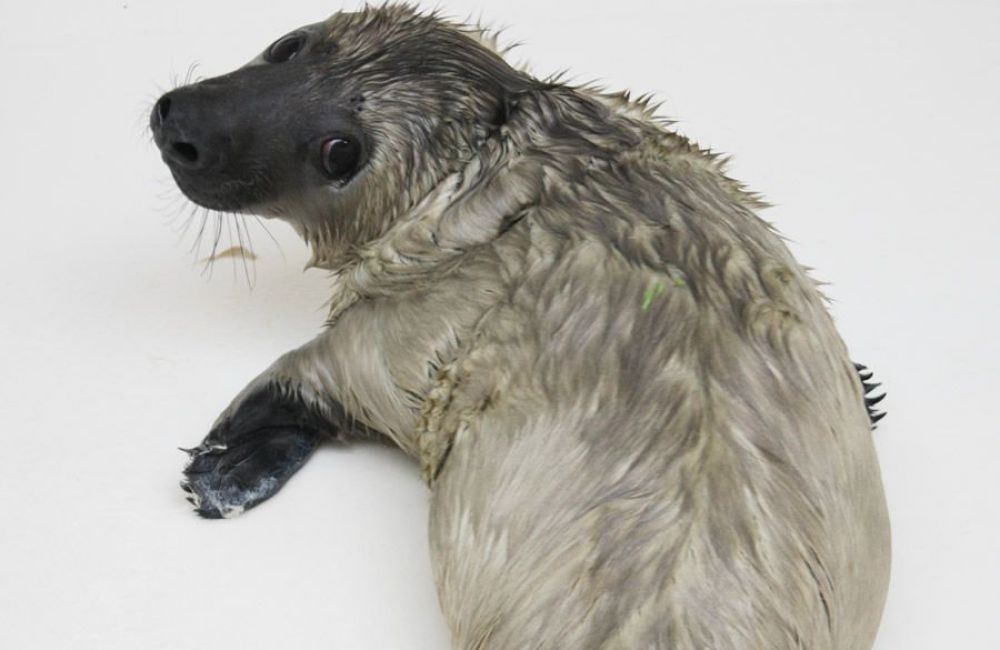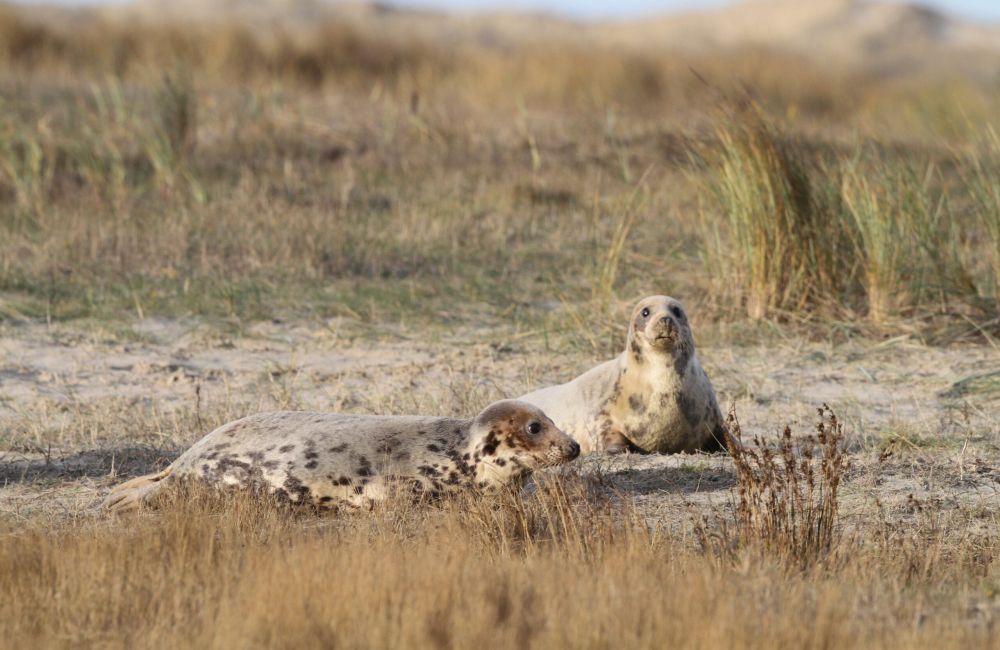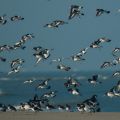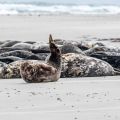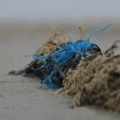Grey seal
Scientific name: Halichoerus grypus
Family: Phocidae
Size: male: 2.70 meter; female: 2.00 meter
Weight: male: 310 kilos; female: 190 kilos
HabitatNorth Atlantic Ocean to the Baltic Sea
Endangered status: not endangered
See also
"Because of its striking nose, the grey seal is sometimes also called "sea pig."
External features of the grey seal
The grey seal has an elongated snout. This is flat from the forehead to the tip of the nose. This makes them a bit like a "real" dog. In addition, the adult males have a very bulbous nose, which is especially striking when you look at them from the side.
Did you know...
The literal translation of the grey seal's scientific name means "hook-nosed sea pig?
The nostrils of the grey seal are large, round and set wide apart. They do not run towards each other, but are straight apart. This has no other seal species and it gives grey seals a sort of pig nose. That's where their scientific name of the grey seal, Halichoerus grypus, comes from which means: "hook-nosed sea pig".
It is a fairly large seal species. An adult male living in the seas of Europe grows to about 2.7 meters in length and can weigh up to 310 kilograms. Adult females are much smaller. They grow to about 2 meters in length and weigh up to 190 kilos. Grey seals in the western Atlantic tend to be quite a bit larger. They sometimes grow up to 3 meters in length and can weigh up to 400 kilos.
Did you know...
The largest grey seal ever measured was 3.30 meters long?
Gender differences
Males are much larger than the females. They usually have a much thicker neck than the females (often with scars from fighting with other males). In addition to size, there are major differences in appearance between males and females in grey seals. The term used in science for this is sexual dimorphism.
They also have a different colour. Adult males have dark brown to black fur with some light spots here and there. The females are much lighter brown or blonde in colour, with dark spots. If a seal's fur is completely black, it is called melanism. This is pretty rare.
Distribution and status
Grey seals live in groups on the coast of the Western Atlantic Ocean in the Northern hemisphere through to the Baltic Sea. The seals of the Atlantic Ocean have probably had no contact with the seals that live in and around the Baltic Sea for thousands of years. That is why we also speak of two “subspecies”. Each of these species has its own scientific name.
- Halichoerus grypus atlantica (in the Atlantic Ocean)
- Halichoerus grypus grypus (in the Baltic Sea)
They are usually found on rocky shores, beaches, sand banks, islands and even - far enough north - on ice floes. Grey seals share their habitat with many other animal species, for example the common seal (Phoca vitulina).
Grey seals have been an endangered species for many years. Due to centuries of hunting by humans, grey seals had completely disappeared in some areas of the world. In the Netherlands, this species had been gone for hundreds of years before they came back in the eighties. In most of Europe they are still a protected species.
Did you know...
There are two types of seals living in the Netherlands. The grey seal and… Do you know the other one? You can find them here.
Grey seals in the Netherlands
In the Netherlands, grey seals can be seen along the entire coast. Most are in and around the Wadden Sea. A smaller group of seals live in the south of the country, in Zeeland. Here, too, they share these areas with common seals.
The grey seal here is doing better now. In 2021, there were 6,788 animals in the Netherlands. This is almost twenty percent more compared to the previous year. There are more and more grey seals worldwide. According to the 2016 IUCN Red List, there were approximately 316,000 adult grey seals. They therefore have the status "not endangered", this is mainly because they are a protected species in many countries.
Diet and foraging
Grey seals eat anything. Depending on where they live and which prey is most present at that time. They're not that p. They eat Atlantic fish species, squid and crustaceans. A few grey seals have also been seen eating birds or even young seals and porpoises.
When looking for food, they usually dive for 4 to 10 minutes, but sometimes they search for up to 30 minutes. While the average dive goes to a depth of 60 to 100 meters, dives have also been measured from 200 meters deep.
Behavior of grey seals
Like other seal species, grey seals only search for food. Although grey seals often rest in large numbers on the coast in some places, they are not seen as very social animals. They usually try to avoid social contact. Except when females feed their pups or during the mating season.
Hier in Nederland zijn er niet echt hele grote groepen met grijze zeehonden. Ze rusten in kleinere groepen op zandplaten of stranden. Elk jaar aan het einde van het voorjaar komen er grotere groepen grijze zeehonden samen om te verharen. Ze raken dan hun wintervacht kwijt. Ze liggen dan een aantal weken wat meer op land. Op het land raken ze de haren makkelijker kwijt. En daar komt bij: het zonlicht is goed voor de nieuwe vacht.
Voortplanting bij grijze zeehonden
Mating behaviour
The female is ready to mate a few days after giving birth. During the mating season, adult grey seals gather on shore or on pack ice to reproduce. The males then compete for females. They do not defend a territory or harem like sea lions. Instead, they fight other males to mate with certain females.
Although their fights seem vicious, grey seals don't fight to the death. Usually, they don't get hurt very badly. Instead, they fight until someone is too tired or realizes they've lost. The strongest males can mate with up to 10 females.
Diapause and pregnancy
The fertilized egg is not moved to the uterus until three to four months after the moment of fertilization. This is called diapause. After that, a grey seal is eight months pregnant. In the time between fertilization and pregnancy, the female must gain a lot of weight. So when her new pup is born, she can take good care of it.
Did you know...
Grey seal pups born with white fur?
Grey seal pups
Grey seal pups are born in winter. Female grey seals give birth to one pup on land or ice. Pups weigh between 11 and 20 kilos at birth and have a white coat in the first few weeks. We call this baby coat “lanugo”. It sometimes takes up to three weeks for the puppy to lose all its white hair, but it usually disappears within a few days.
Birth and nursing period
The nursing period lasts about three weeks. During this time, the pup will gain four times its weight. This is due to the fatty breast milk, which contains approximately 43% fat in grey seals. Because the female has to stay with her pup a lot, she has little time to eat and she loses a lot of weight. Female grey seals sometimes weigh as much as 40% less after this period.
After 3 weeks of nursing, the mother has no breast milk left. She leaves her pup and is not coming back. The first few days the pup will stay on land, because the lanugo coat is not suitable for swimming. The pup will not eat. They then begin to lose the white fur and lose weight until they are finally ready to enter the water.
Then they learn to hunt for themself. Without help from the mother: natural instinct takes over. It is not for nothing that the grey seal is the largest predator in the Netherlands.
